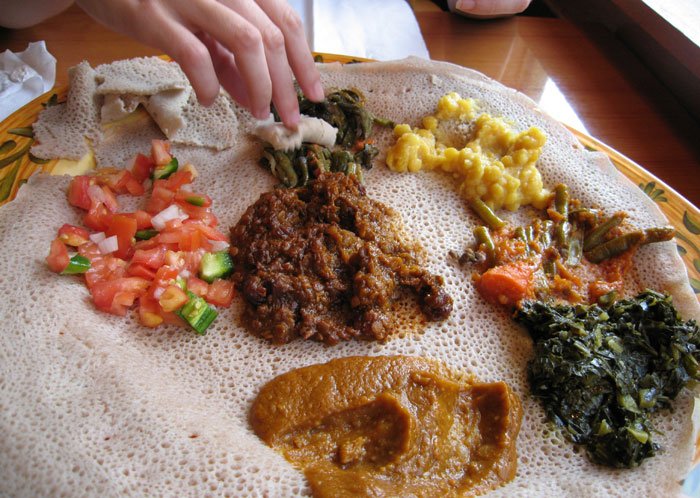Ethiopia has a wide variety of different dishes; most of them are unique to the country. The principal source of carbohydrates in Ethiopia is injera, a large, pancake-shaped substance made from tef grain that is unique to Ethiopia. Injera is not a sole dish but it always has accompaniment, which is called wot, literally sauce or curry. The ritual is to take a piece of injera with your hand, wrap the sauce within it and eat. If you dine with Ethiopians, it is a tradition for everyone to eat together on the same plate.
The common non-vegetarian sauce to be served with injera is tibs (literally ‘meat fried’), freshly fried meat, moderately spiced and mixed with onions. It often served with a red powder of chilli called mitmita on the side. Most recommended is shekla tibs, where the fried meat is served in a clay pot that contains a charcoal burner underneath. The other favourite dish is kitfo, prepared from minced and warmed (not cooked) meat in a pan with a little butter, mitmita (powder of strong chilli) and typically aib (like dry cottage cheese) and gomen (minced spinach).
Not for the faint-hearted, but one of Ethiopia’s most popular delicacies is raw red meat which is served with injera and chilli in a sauce or powder form. Even though no adverse effect for most Ethiopians, eating tere siga and kitfo may have a relative health risk. During religious holidays, doro wot, which is made with cooked chicken drumsticks, wings and boiled eggs and served in a hot sauce of butter, onion, and chilli.

Ethiopian injera, a mix of different stewed vegetables and pastes that you wrap up in the amazing injera bread. Ethiopian food is such a fun experience. Picture by LollyKnit (CC BY 2.0)
Most places will serve injera with a vegan accompaniment. The common accompaniment are shiro, spicy mashed chickpeas served in the form of paste; kik or misr wot, a similar dish to shiro but made from beans or lentils. The other popular dish is beyainetu, which is literally ‘vegetable buffet’, comprising separate piles of tasty and colourful vegetables, potatoes, curries, and lentil stews in a circle on the injera. In addition to the dishes mentioned above which are common in most of the country, there are a wide variety of dishes served uniquely in different ethnic groups.
As Ethiopia is thought to be the origin of coffee, and the coffee bean accounts for more than half of Ethiopia’s exports, it will not be a surprise that Ethiopians are coffee lovers. The local espresso-style coffee (buna), made in clay/metal pots or machines, is served in restaurants, hotels or on streets. Ethiopia is known for the traditional coffee ceremony, in which the grains are roasted over charcoal, ground while the water is boiled, then used to make three successive pots of coffee. Coffee ceremony serves the purpose of getting together with relatives, neighbours, or other visitors. In Addis Ababa, Tomoca coffee is very popular and most recommended. Others include Mokarar (Harar) coffee, Alem Bunna, Kaldi’s coffee and Yod Abyssinia for the best traditional coffee ceremony.

Roasting green/raw coffee beans before preparing the outstanding Ethiopian coffee. Picture by Steve Evans (CC BY 2.0)
The usual soft drinks, generically termed ‘leslasa’ are widely available and are very cheap. There are also non-alcoholic malt beverage, namely Harar Sofi, Malta, and Negus, which is coffee flavoured. Many brands of beer are sold throughout Ethiopia, namely Habesha, Castel, Bati, Bedele, St George, Harar, Walia, Dashen and Heineken. In addition to imported wines and other beverages, Ethiopia has been a wine producer for several decades, some of the brands are Gouder, Awash, Acacia, and Rift Valley.
The most common local alcoholic drink is tej, a honey wine made from honey and gesho (a plant that locally serves as hops in beer). The other most common and traditionally brewed beer is called tella, made from millet or maize, sorghum and gesho. These traditional drinks are not served in normal bars. They are served in the countryside and small towns or specific places in cities.





Hi, this is a comment.
To get started with moderating, editing, and deleting comments, please visit the Comments screen in the dashboard.
Commenter avatars come from Gravatar.